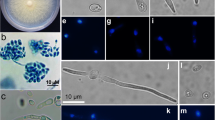Summary
The insect pathogenic hyphomycete Metarhizium anisopliae was transformed to benomyl resistance using pBENA3, a plasmid containing the benA3 allele from Aspergillus nidulans. The transformation rate was 9 transformants/50 μg DNA/2×106 viable protoplasts. Southern hybridization analyses indicated that the plasmid integrated by nonhomologous recombination at multiple loci. The sites of integration differed among transformants. There was no evidence for autonomous plasmid replication in the transformants. Transformants grew at benomyl concentrations up to 10 times that which inhibits wild type, and they were mitotically stable on either selective or non-selective medium or insect tissue. The transformants were pathogenic to the hornworm, Manduca sexta, producing both appressoria and the cuticle-degrading enzyme, chymoelastase, in the presence of 50 μg/ml of benomyl. These studies demonstrate the potential of using transgenic strains of entomopathogenic fungi along with other components of pest control such as fungicides.
Similar content being viewed by others
References
Case ME, Schweizer M, Kushner SR, Giles NH (1979) Proc Natl Acad Sci USA 76:5259–5263
Feinberg AP, Vogelstein B (1983) Anal Biochem 132:6–13
Feinberg AP, Vogelstein B (1984) Anal Biochem 137:266–267
Henson JM, Blake NK, Pilgeram AL (1989) Curr Genet 14:113–117
Huang D, Bhairi S, Staples RC (1989) Curr Genet 15:411–414
Maniatis T, Fritsch EF, Sambrook J (1982) Molecular cloning: a laboratory manual. Cold Spring Harbor Laboratory, Cold Spring Harbor, New York
May GS, Gambino J, Weatherbee JA, Morris NR (1985) J Cell Biol 101:712–719
Orbach MJ, Porro EB, Yanofsky C (1986) Mol Cell Biol 6:2452–2461
Parsons KA, Chumley FG, Valent B (1987) Proc Natl Acad Sci USA 84:4161–4165
Sheir-Neiss G, Lai MH, Morris NR (1978) Cell 15:639–647
Smith M (1985) Annu Rev Genet 19:423–462
St Leger RJ, Charnley AK, Cooper RM (1986) J Invert Pathol 47:295–302
St Leger RJ, Cooper RM, Charnley AK (1987) J Gen Microbiol 133:1371–1382
Turgeon BG, Garber RC, Yoder OC (1985) Mol Gen Genetics 201:450–453
Turgeon BG, Garber RC, Yoder OC (1987) Mol Cell Biol 7:3297–3305
Wraight SP, Roberts DW (1987) In: Pierce G (ed) Developments in industrial microbiology. Society for Industrial Microbiology, New York, pp 77–87
Yelton MM, Hamer JE, Timberlake WE (1984) Proc Natl Acad Sci USA 81:1470–1471
Yoder OC, Weltring K, Turgeon BG, Garber RC, VanEtten HD (1988) In: Maramorsch K (ed) Biotechnology in invertebrate pathology and cell culture. Academic Press, New York, pp 197–218
Author information
Authors and Affiliations
Additional information
Communicated by H. Bertrand
Rights and permissions
About this article
Cite this article
Goettel, M.S., Leger, R.J.S., Bhairi, S. et al. Pathogenicity and growth of Metarhizium anisopliae stably transformed to benomyl resistance. Curr Genet 17, 129–132 (1990). https://doi.org/10.1007/BF00312857
Received:
Accepted:
Issue Date:
DOI: https://doi.org/10.1007/BF00312857




